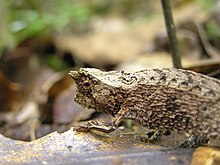Chameleon
ABOUT THE CHAMELEON
Kingdom:Animalia
Phylum:Chordata
Class:Reptilia
Order:Squamata
Family:Chamaeleonidae
Scientific Name:Chamaeleonidae
Type:Reptile
Diet:Omnivore
Size (L):2.8cm - 68.5cm (1.1in - 27in)
Weight:0.01kg - 2kg (0.02lbs - 4.4lbs)
Top Speed:35km/h (21mph)
Life Span:4 - 8 years
Lifestyle:Solitary
Conservation Status:Threatened
Colour:Green, Brown, Black, Yellow, Red, Tan
Skin Type:Scales
Favourite Food:Insects
Habitat:Tropical forests and desert
Average Clutch Size:20
Main Prey:Insects, Snails, Leaves
Predators:Snakes, Birds, Mammals
Distinctive Features:Exceptional vision and ability to change skin colour
___________________________________________________________________________________
Chameleons or chamaeleons (family Chamaeleonidae) are a distinctive and highly specialized clade of Old World lizards with 202 species described as of June 2015.[1] These species come in a range of colors, and many species have the ability to change color.
Chameleons are distinguished by their zygodactylous feet; their very extensive, highly modified, rapidly extrudable tongues; their swaying gait;[2] and crests or horns on their brow and snout. Most species, the larger ones in particular, also have a prehensile tail. Chameleons' eyes are independently mobile, but in aiming at a prey item, they focus forward in coordination, affording the animal stereoscopic vision.
Chameleons are adapted for climbing and visual hunting. They live in warm habitats that range from rain forest to desert conditions, with various species occurring in Africa, Madagascar, southern Europe, and across southern Asia as far as Sri Lanka. They also have been introduced to Hawaii, California, and Florida, and often are kept as household pets.
HABITATS
Chameleons primarily live in the mainland of sub-Saharan Africa and on the island of Madagascar, although a few species live in northern Africa, southern Europe, the Middle East, southern India, Sri Lanka, and several smaller islands in the western Indian Ocean. There are introduced, feral populations of veiled and Jackson's chameleons in Hawaii, and isolated pockets of feral Jackson's chameleons have been reported in California and Florida.
Chameleons inhabit all kinds of tropical and mountain rain forests, savannas, and sometimes deserts and steppes. The typical chameleons from the subfamily Chamaeleoninae are arboreal, usually living in trees or bushes, although a few (notably the Namaqua chameleon) are partially or largely terrestrial. Most species from the subfamily Brookesiinae, which includes the genera Brookesia, Rieppeleon, and Rhampholeon, live low in vegetation or on the ground among leaf litter. Many species of chameleons are threatened by extinction. Declining chameleon numbers are due to habitat loss.
LIFE CYCLE
The life cycle of chameleons is largely similar to that of other lizards. After birth or hatching from their eggs, chameleons begin eating and growing. Most species mature relatively quickly -- within three to 12 months, depending on the species – and begin seeking out conspecifics, defending territory and mating. They dedicate most of their adult lives to reproduction, and chameleons usually attempt to breed until they die. However, the more than 150 living chameleon species exhibit considerable variation in life history, primarily as it relates to their reproductive strategy.
FEEDING
All chameleons are primarily insectivores that feed by ballistically projecting their long tongues from their mouths to capture prey located some distance away.While the chameleons' tongues are typically thought to be one and a half to two times the length of their bodies (their length excluding the tail), smaller chameleons (both smaller species and smaller individuals of the same species) have recently been found to have proportionately larger tongue apparatuses than their larger counterparts.[36] Thus, smaller chameleons are able to project their tongues greater distances than the larger chameleons that are the subject of most studies and tongue length estimates, and can project their tongues more than twice their body length.
UNIQUENESS
Chameleons mostly live in the rain forests and deserts of Africa. The color of their skin helps them blend in with their habitats. Chameleons that hang out in trees are usually green. Those that live in deserts are most often brown.
They often change color to warm up or cool down. (Turning darker helps warm the animals because the dark colors absorb more heat.) They also switch shades to communicate with other chameleons, using bright colors to attract potential mates or warn enemies.
So how exactly do chameleons change colors? The outer layer of their skin is see-through. Beneath that are layers of special cells filled with pigment—the substance that gives plants and animals (including you) color. To display a new color, the brain sends a message for these cells to get bigger or smaller. As this happens, pigments from different cells are released, and they mix with each other to create new skin tones. For instance, red and blue pigment may mix to make the chameleon look purple.
They often change color to warm up or cool down. (Turning darker helps warm the animals because the dark colors absorb more heat.) They also switch shades to communicate with other chameleons, using bright colors to attract potential mates or warn enemies.
So how exactly do chameleons change colors? The outer layer of their skin is see-through. Beneath that are layers of special cells filled with pigment—the substance that gives plants and animals (including you) color. To display a new color, the brain sends a message for these cells to get bigger or smaller. As this happens, pigments from different cells are released, and they mix with each other to create new skin tones. For instance, red and blue pigment may mix to make the chameleon look purple.
| 1. Why does a chameleon change its color? because chameleon have a pigment inside their skin. 2. What are the distinctive features of the chameleon? they can change their skin colours. 3. What is the specialty of the tongue of a chameleon? chameleon have a very long tongue to help they hunt.
| ||||||



Komentar
Posting Komentar